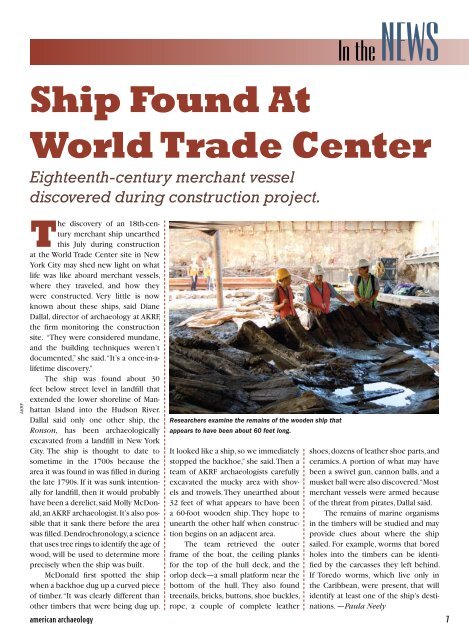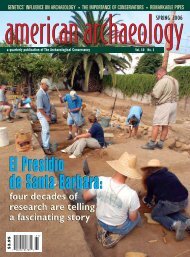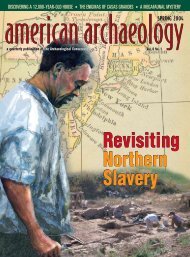Clovis Comet Debate - The Archaeological Conservancy
Clovis Comet Debate - The Archaeological Conservancy
Clovis Comet Debate - The Archaeological Conservancy
You also want an ePaper? Increase the reach of your titles
YUMPU automatically turns print PDFs into web optimized ePapers that Google loves.
Ship Found At<br />
In theNEWS<br />
World Trade Center<br />
Eighteenth-century merchant vessel<br />
discovered during construction project.<br />
tury merchant ship unearthed<br />
this July during construction<br />
at the World Trade Center site in New<br />
York City may shed new light on what<br />
life was like aboard merchant vessels,<br />
where they traveled, and how they<br />
were constructed. Very little is now<br />
known about these ships, said Diane<br />
Dallal, director of archaeology at AKRF,<br />
the firm monitoring the construction<br />
site. “<strong>The</strong>y were considered mundane,<br />
and the building techniques weren’t<br />
documented,” she said. “It’s a once-in-alifetime<br />
discovery.”<br />
<strong>The</strong> ship was found about 30<br />
feet below street level in landfill that<br />
extended the lower shoreline of Man-<br />
hattan Island into the Hudson River.<br />
Dallal said only one other ship, the<br />
Ronson, has been archaeologically<br />
excavated from a landfill in New York<br />
City. <strong>The</strong> ship is thought to date to<br />
sometime in the 1700s because the<br />
area it was found in was filled in during<br />
the late 1790s. If it was sunk intentionally<br />
for landfill, then it would probably<br />
have been a derelict, said Molly McDonald,<br />
an AKRF archaeologist. It’s also possible<br />
that it sank there before the area<br />
was filled. Dendrochronology, a science<br />
that uses tree rings to identify the age of<br />
wood, will be used to determine more<br />
precisely when the ship was built.<br />
McDonald first spotted the ship<br />
when a backhoe dug up a curved piece<br />
of timber. “It was clearly different than<br />
other timbers that were being dug up.<br />
akrf <strong>The</strong> discovery of an 18th-cen-<br />
Researchers examine the remains of the wooden ship that<br />
appears to have been about 60 feet long.<br />
It looked like a ship, so we immediately<br />
stopped the backhoe,” she said. <strong>The</strong>n a<br />
team of AKRF archaeologists carefully<br />
excavated the mucky area with shovels<br />
and trowels. <strong>The</strong>y unearthed about<br />
32 feet of what appears to have been<br />
a 60-foot wooden ship. <strong>The</strong>y hope to<br />
unearth the other half when construction<br />
begins on an adjacent area.<br />
<strong>The</strong> team retrieved the outer<br />
frame of the boat, the ceiling planks<br />
for the top of the hull deck, and the<br />
orlop deck—a small platform near the<br />
bottom of the hull. <strong>The</strong>y also found<br />
treenails, bricks, buttons, shoe buckles,<br />
rope, a couple of complete leather<br />
shoes, dozens of leather shoe parts, and<br />
ceramics. A portion of what may have<br />
been a swivel gun, cannon balls, and a<br />
musket ball were also discovered. “Most<br />
merchant vessels were armed because<br />
of the threat from pirates, Dallal said.<br />
<strong>The</strong> remains of marine organisms<br />
in the timbers will be studied and may<br />
provide clues about where the ship<br />
sailed. For example, worms that bored<br />
holes into the timbers can be identified<br />
by the carcasses they left behind.<br />
If Toredo worms, which live only in<br />
the Caribbean, were present, that will<br />
identify at least one of the ship’s destinations.<br />
—Paula Neely<br />
american archaeology 7




